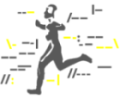





Search | Sitemap | Navigation |  |
|
||||||||||||||||||||||||||
|
||||||||||||||||||||||||||
|
||||||||||||||||||||||||||
|
| Chris Delle Fave |
Salvador Dali (1904-1989)
Gala-Salvador Dali Foundation
dali & picasso. freakizh brain + pain: the perfect formula for art?
A Famous Migraine Suspect"My mom and I have always thought Picasso might have had them." (Leeanna English, Newsgroups: alt.support.headaches.migraine, Subject: Re: Famous migraineurs, August 2, 1997) "Then Salvador Dali must have had them too!" (Helen Simmons, Newsgroups: alt.support.headaches.migraine, Subject: Re: Famous migraineurs, August 2, 1997) |

Salvador Dali, The Persistence of Memory, 1931. © Salvador Dali. Foundation Gala-Salvador Dali/ VG Bild-Kunst, Bonn 2005
"The Persistence of Memory (1931) ... demonstrates the stretchability of time. In this picture the remains and super-softness of a Camembert cheese he saw after dinner when he stayed at home with migraine inspired him to paint the extraordinary soft watches." (Cited from Abraham Tamir, Einstein's Universe via Art, October 2, 2003)
A migraine sufferer's report"I clearly remember my first migraine. I was visiting with friends, when a strange zig zag of light flashed across one eye, almost like lightening. Like a Salvatore Dali painting everything seemed surreal, almost as if the room were melting. People were talking to me, but I couldn't understand. Like an out of body experience, I felt disoriented and weak, my arm went numb and everything seemed as if I were looking through broken glass. Then came the pain. The awful throbbing pain that lasted for two days with no relief. I was sure it was brain tumor, so I went to a neurologist who, after much testing, told me I suffered from classic migraine." (Diane Meredith Bentley, Introduction to "A Migraine Sufferer's Cookbook", http://www.trafford.com/ 4dcgi/view-item?item=2292&222195649-28665aaa, September 1, 2004) |
"Other artists such as... Salvador Dali... also capture that optical effect of a migraine attack." (Cited from Alexandra Anderson, Optical Migraine Images, April 9, 2003)

Luis Buñuel and Salvador Dali, Enlarged frame from the film "Un Chien Andalou", 1928. Luis Buñuel and Salvador Dali, Enlarged frame from the film "Un Chien Andalou", 1928. © Salvador Dali. Foundation Gala-Salvador Dali/ VG Bild-Kunst, Bonn 2005
Paul West (1975) suggested as an emblem of migraine "the sliced eye from Buñuel's Un Chien Andalou, a movie I cannot watch without marvelling at its decipherment of the migrainee's longing to pluck out the sloven half of the jelly that offends".
Critical Paranoia, or how to decisively split your vision in new directions...By James SeborSalvador Dali developed the concept of Critical Paranoia for establishing a creative state of self-induced psychosis. Andre Breton often maligned him for its uses, a sign of its relative importance and usefulness. Consider the process akin to forcing a waking dream, a conscious transformation led by paranoid scrutiny of what presents itself in the surroundings. The simplest version, hardly critical, hardly paranoid, begins with the child's game of staring into banks of clouds, looking for the chariot riders, the giants and other fantasms of humidity. Elementary exercises can also be practiced through prolonged staring at ink blots, scribble drawings and the array of optical illusions that sell themselves in one of many new-age, self-help manuals designed to prove that you are on your way to a happier existence. Those cracks in the sidewalk, they look like an outline of the west coast of Mexico. More advanced practitioners will find the intricacies of television static a delight to behold. The onset of migraine headaches a resounding flourish. (James Sebor, Critical Paranoia, http://www.seaboarcreations.com/criticalparanoia.htm, September 1, 2004) |
Inspiration, mediumship, surrealism: The concept of creative dissociation (excerpts)By Michael GrossoSalvador Dali developed something he called "paranoic critical activity," the main idea being to try systematically to concretize one's obsessions. Dali's were with putrefaction, masturbation, time, death, hell, and so on. Paranoiac critical activity is similar to Victor Frankl's paradoxical intention. Instead of denying or repressing the negative, we affirm and express it; we force ourselves to look at it in a concrete way. We exaggerate, make it monstrous, as Rimbaud said. We get the paranoia out of our system, so to speak, and at the same time, transform it into something artistically engaging or therapeutically helpful. This "activity" seems to me part of the healing power of art. It must have worked for Dali, who said, "The only difference between me and a madman is that I am not mad" (Bosquet, 1969, p. 83)... Surreality - my candidate for the advanced development of creative dissociation - was an attempt to revive the cult of the Muses... For Breton, de Chirico, Dali, and company, dissociation was the basis of a cultural revolution, a kind of post-religious eschatology that preached the necessity for disengagement from and destruction of the prevailing reality principle. (Cited from Grosso, Inspiration, mediumship, surrealism: The concept of creative dissociation, 1998, www.nidsci.org/pdf/grosso.pdf, January 7, 2005) |
References
West P. The lightning-rod man. The migraine headache as heuristic tool. J Gen Educ 1975; 26: 291-300. (Reprinted in: West P, A Stroke of Genius: Illness and Self-Discovery. Viking, New York 1995)
Bentley DM. A Migraine Sufferer's Cookbook: Feeling Better With Additive Free Food. (No Information on Publisher), 2003.
Bosquet A. Conversations with Dali. Dutton, New York 1969.
Grosso M. Inspiration, mediumship, surrealism: The concept of creative dissociation. In: Krippner S, Powers SM (eds) Broken Images, Broken Selves: Dissociative Narratives in Clinical Practice. Brunner/Mazel, Publishers, New York 1998.
Last modification of this page: Wednesday March 23. 2005
Author: Klaus Podoll
| Chris Delle Fave |
 Top of the page
Top of the page| · | News |
| · | Medical Professionals |
| · | Medical Studies |
| · | Pablo Picasso |
| · | |
Copyright © 2005 Migraine Aura Foundation, All rights reserved. Last modification of this site: August 25, 2006
Thanks to: RAFFELT MEDIENDESIGN and GNU software | webmaster@migraine-aura.org
http://migraine-aura.org/EN/Salvador_Dali.html


